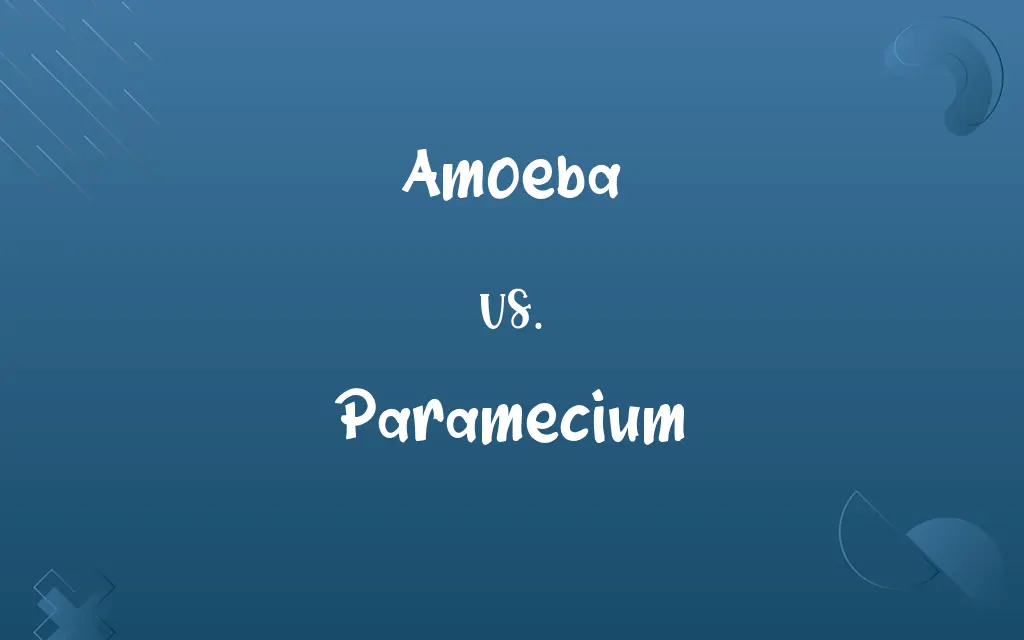Amoeba vs. Paramecium: Know the Difference

By Shumaila Saeed || Published on January 9, 2024
Amoeba is a shapeless, unicellular organism moving via pseudopodia, while Paramecium is a slipper-shaped, unicellular organism using cilia for movement.

Key Differences
Amoeba possesses a flexible shape, constantly changing due to the formation of pseudopodia (false feet) for movement and feeding. Paramecium, in contrast, has a fixed, slipper-like shape with a rigid structure and moves using numerous tiny hair-like structures called cilia.
Shumaila Saeed
Jan 09, 2024
Amoeba typically thrives in freshwater environments, soil, and in some parasitic forms, inside host organisms. Paramecium is mainly found in freshwater environments, where its cilia not only aid in movement but also in creating currents to channel food particles towards its oral groove.
Shumaila Saeed
Jan 09, 2024
The Amoeba engulfs food particles through a process called phagocytosis, where it extends its pseudopodia around the food to enclose it in a food vacuole. Paramecium feeds by sweeping food particles into its oral groove using cilia, where they are then engulfed into food vacuoles.
Shumaila Saeed
Jan 09, 2024
Amoeba generally reproduces asexually through binary fission, where the cell divides into two daughter cells. Paramecium also reproduces primarily asexually by binary fission, but it can engage in a form of sexual reproduction known as conjugation for genetic variation.
Shumaila Saeed
Jan 09, 2024
Amoebas play a key role in the decomposition process and nutrient cycling in their environments. Paramecia, being a part of the aquatic food chain, serve as food for larger organisms and aid in controlling algae populations.
Shumaila Saeed
Jan 09, 2024
ADVERTISEMENT
Comparison Chart
Shape and Structure
Shapeless, flexible body
Fixed, slipper-like shape with rigid body
Shumaila Saeed
Jan 09, 2024
Feeding Mechanism
Phagocytosis using pseudopodia
Uses cilia to sweep food into oral groove
Shumaila Saeed
Jan 09, 2024
Reproduction
Asexual through binary fission
Asexual by binary fission and conjugation
Shumaila Saeed
Jan 09, 2024
ADVERTISEMENT
Ecological Role
Decomposition, nutrient cycling
Controls algae, part of the food chain
Shumaila Saeed
Jan 09, 2024
Cellular Complexity
Simple structure, less specialized
More complex and specialized
Shumaila Saeed
Jan 09, 2024
Sensory Organelles
Lacks specialized sensory organelles
Has specialized structures like trichocysts
Shumaila Saeed
Jan 09, 2024
Osmoregulation
Uses contractile vacuoles for osmosis
Contractile vacuoles for water regulation
Shumaila Saeed
Jan 09, 2024
Interaction with Host
Can be parasitic in some forms
Generally free-living, not parasitic
Shumaila Saeed
Jan 09, 2024
ADVERTISEMENT
Amoeba and Paramecium Definitions
Amoeba
Amoeba reproduces asexually through a process called binary fission.
Under favorable conditions, an amoeba can rapidly reproduce by binary fission.
Shumaila Saeed
Dec 28, 2023
Paramecium
It has a distinctive slipper-shaped body covered with cilia.
The paramecium's slipper shape and cilia are easily identifiable under a microscope.
Shumaila Saeed
Dec 28, 2023
Amoeba
Amoebas play an important role in soil nutrient cycling.
Amoebas contribute to the decomposition of organic matter in soil ecosystems.
Shumaila Saeed
Dec 28, 2023
Paramecium
Paramecium is a ciliated, unicellular organism commonly found in freshwater.
In the pond water sample, we observed numerous paramecia swimming rapidly.
Shumaila Saeed
Dec 28, 2023
Amoeba
Amoeba is a unicellular organism known for its shapeless form.
In biology class, we observed an amoeba changing shape under the microscope.
Shumaila Saeed
Dec 28, 2023
Paramecium
Paramecium uses its cilia for locomotion and feeding.
The paramecium's cilia help sweep food into its oral cavity.
Shumaila Saeed
Dec 28, 2023
Amoeba
It moves and feeds using temporary extensions called pseudopodia.
The amoeba extended its pseudopodia to engulf a nearby food particle.
Shumaila Saeed
Dec 28, 2023
Paramecium
It can reproduce asexually and engage in conjugation for genetic exchange.
Paramecia can undergo conjugation, exchanging genetic material with another individual.
Shumaila Saeed
Dec 28, 2023
Amoeba
Any of various one-celled free-living or parasitic protozoans having no definite form and moving by means of pseudopods.
Shumaila Saeed
Dec 27, 2023
Paramecium
Paramecium serves as a key component of the aquatic food chain.
Paramecia are essential in the diet of many small aquatic organisms.
Shumaila Saeed
Dec 28, 2023
Amoeba
(biology) A member of the genus Amoeba of unicellular protozoa that moves by means of temporary projections called pseudopodia.
Shumaila Saeed
Dec 27, 2023
Paramecium
Any of various slipper-shaped freshwater ciliate protozoans of the genus Paramecium, having an oral groove for feeding.
Shumaila Saeed
Dec 27, 2023
Amoeba
(mathematics) The graph of the real part of the logarithms of a polynomial equation in complex numbers.
Shumaila Saeed
Dec 27, 2023
Amoeba
A rhizopod common in fresh water, capable of undergoing many changes of form at will. Same as ameba. See Rhizopoda.
Shumaila Saeed
Dec 27, 2023
Amoeba
Naked freshwater or marine or parasitic protozoa that form temporary pseudopods for feeding and locomotion
Shumaila Saeed
Dec 27, 2023
Amoeba
Some amoebas are free-living, while others are parasitic.
Amoebic dysentery is caused by a parasitic form of amoeba.
Shumaila Saeed
Dec 28, 2023
Repeatedly Asked Queries
What is a Paramecium?
A unicellular, ciliated organism commonly found in freshwater environments.
Shumaila Saeed
Jan 09, 2024
How does an Amoeba move?
By extending its cell membrane to form pseudopodia.
Shumaila Saeed
Jan 09, 2024
What is an Amoeba?
A unicellular organism that moves and feeds using pseudopodia.
Shumaila Saeed
Jan 09, 2024
What type of reproduction is common in Amoeba?
Asexual reproduction through binary fission.
Shumaila Saeed
Jan 09, 2024
Is Paramecium harmful to humans?
No, it's generally harmless and not parasitic.
Shumaila Saeed
Jan 09, 2024
What is the typical habitat of an Amoeba?
Freshwater environments, soil, and some are parasitic.
Shumaila Saeed
Jan 09, 2024
What is the typical habitat of a Paramecium?
Mainly found in freshwater bodies.
Shumaila Saeed
Jan 09, 2024
How does a Paramecium obtain its food?
By sweeping food particles into its oral groove using cilia.
Shumaila Saeed
Jan 09, 2024
What ecological role does a Paramecium play?
Part of the aquatic food chain, controlling algae populations.
Shumaila Saeed
Jan 09, 2024
How does an Amoeba obtain its food?
Through phagocytosis, engulfing food particles with pseudopodia.
Shumaila Saeed
Jan 09, 2024
What ecological role does an Amoeba play?
Decomposer in soil and water ecosystems, nutrient cycling.
Shumaila Saeed
Jan 09, 2024
How do Amoebas handle excess water?
Using contractile vacuoles to expel excess water.
Shumaila Saeed
Jan 09, 2024
Are there different species of Amoeba?
Yes, there are many species, some free-living and some parasitic.
Shumaila Saeed
Jan 09, 2024
Are there different species of Paramecium?
Yes, there are several species, each with distinct characteristics.
Shumaila Saeed
Jan 09, 2024
Can Amoeba be harmful to humans?
Some parasitic forms can cause diseases like amoebic dysentery.
Shumaila Saeed
Jan 09, 2024
How do Paramecia handle excess water?
They also use contractile vacuoles for osmoregulation.
Shumaila Saeed
Jan 09, 2024
Can Amoebas survive in different environments?
Yes, some are adaptable to various environments, including inside hosts.
Shumaila Saeed
Jan 09, 2024
What is the lifespan of a Paramecium?
Varies, but typically a few days to a few weeks in ideal conditions.
Shumaila Saeed
Jan 09, 2024
What type of reproduction is common in Paramecium?
Asexual by binary fission and sexual through conjugation.
Shumaila Saeed
Jan 09, 2024
Share this page
Link for your blog / website
HTML
Link to share via messenger
About Author
Written by
Shumaila SaeedShumaila Saeed, an expert content creator with 6 years of experience, specializes in distilling complex topics into easily digestible comparisons, shining a light on the nuances that both inform and educate readers with clarity and accuracy.








































































